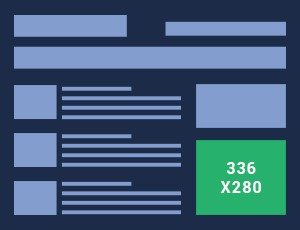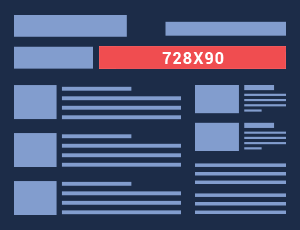-
 7 min. read
7 min. read
-
 Trevin Shirey
Trevin Shirey VP of Marketing
VP of Marketing
- Trevin serves as the VP of Marketing at WebFX. He has worked on over 450 marketing campaigns and has been building websites for over 25 years. His work has been featured by Search Engine Land, USA Today, Fast Company and Inc. Read his review of working with WebFX for the last 15 years.
Following up with your target audience is valuable. Retargeting can draw previous visitors to your website, driving sales and revenue. If you’re launching a remarketing campaign on Google Ads, though, its display network offers ad sizes in a range of shapes and placements.
Which of Google’s display ad sizes are best for your business? Let’s look at the features and benefits of the 17 Google ad sizes to find out!
The 17 Google display ad sizes
1. Banner (468 x 60)
When your potential customers are browsing, the first thing they see on websites is the top of a page or above the fold, and your ads can be there to meet them. Banner ads roll across the upper part of the page, and they can grab attention to initiate your remarketing efforts. Normally in contrast to the leaderboard ad, they are thin and long.
2. Half banner (234 x 60)
If you’re looking for an ad with a small but powerful scope, the half banner ad can suit your needs. It fits into narrower areas, but its reach to audiences is less substantial due to poor ad inventory on websites. This Google Ads size is shorter, diminishing room for text, but it can tactfully direct viewers to your website and services with powerful images.
3. Mobile banner (320 x 50)
The mobile banner only appears on mobile devices, but it pinpoints a significant group of people. In 2021, 97 percent of American adults reported owning a smartphone, which is a surge from the 35 percent who owned smartphones in 2011. Mobile internet usage has also increased, which means mobile marketing is full of potential. While people are scrolling on their smartphones or tablets, your banner can achieve beneficial exposure.
4. Large mobile banner (320 x 100)
*Top Performing ad size Reinforcing your ad campaign on personal technology is strategic, and large mobile banners dispatch retargeting better than the plain mobile banner size. American households are accessing the Internet via mobile broadband in rising numbers, so prominent mobile ad sizes can engage potential customers well. The large mobile banner ad can make use of mobile activity and captivate past visitors.
5. Vertical banner (120 x 240)
Similar to the half banner size, vertical banners can occupy tight spaces. Thin ads can get into these close spots, but their readability doesn’t match wider ads. You can have difficulty inserting sentences and reasonable call-to-action (CTA) messages in the existing space.
It’s also not amply supplied by the Google Ads network.
6. Square (250 x 250)
Appearing on both mobile electronics and computers, the square size is a versatile and advantageous proportion. Square is also a responsive ad type, so it adjusts to the most accessible spots on pages. Straightforward square ads typically hug the side panels, though. Arranging images and text on these is manageable, and adaptable ads can get your message back to previous viewers with ease.
7. Small square (200 x 200)
Small square ads have many of the same perks as the regular square size, but they are slightly less noticeable. You can still capitalize on the demonstrated interest of visitors with these, but they serve a more subtle purpose. They are also compatible with mobile browsers.
8. Small rectangle (180 x 150)
While rectangle ads usually generate traffic, small rectangle ads are the least impactful size in display advertising. They can accommodate compact pages, and they are more affordable due to lower competition.
9. Half page (300 x 600)
*Top Performing ad size  Although half-page ads don’t take up half of the page as their name suggests, they perform well and richly communicate information to readers. This may be because half-page ads take up a larger portion of website real estate than other ads. Half-page ads are set on the side and have an impression rate that’s seeing rapid growth.
Although half-page ads don’t take up half of the page as their name suggests, they perform well and richly communicate information to readers. This may be because half-page ads take up a larger portion of website real estate than other ads. Half-page ads are set on the side and have an impression rate that’s seeing rapid growth.
Due to a generous size, viewers have to look at them for a longer period of time, which can encourage more clicks and conversions.
10. Large rectangle (336 x 280)
*Top Performing ad size  As Google Ads offers a high inventory of large rectangle ads, they can boost conversions and bring in revenue. When embedded in content, these get better reactions from viewers, and combining visual and text components can boost their performance even more.
As Google Ads offers a high inventory of large rectangle ads, they can boost conversions and bring in revenue. When embedded in content, these get better reactions from viewers, and combining visual and text components can boost their performance even more.
11. Skyscraper (120 x 600)
Situated on the sides of pages, skyscrapers are tall ads, which restrict word placement. These Google retargeting ad sizes are vertical, so they’re less sought-after by businesses. However, this results in a lower cost.
Skyscraper ads also still hold a fair chance of getting your audience to visit your site again, so they’re worth considering.
12. Wide skyscraper (160 x 600)
To help people remember your brand, you can use wide skyscraper ads as your Google display ad size. With more abundant space availability, these are a useful vertical Google ad size. Along the sides of websites, these offer a broader area than the conventional skyscraper ad.
13. Medium rectangle (300 x 250)
 *Top Performing ad size With an exceptional amount of available space across the Google Display Network, medium rectangle ads are some of the most successful Google retargeting ad sizes. They can appear on smartphones, tablets, and computers, and can display within text or at the bottom of pages, especially after articles.
*Top Performing ad size With an exceptional amount of available space across the Google Display Network, medium rectangle ads are some of the most successful Google retargeting ad sizes. They can appear on smartphones, tablets, and computers, and can display within text or at the bottom of pages, especially after articles.
14. Portrait (300 x 1050)
Portrait ads are an emerging unit size for retargeting because they’re eye-catching. While in high demand, websites don’t have a large volume of ad inventory for them yet. Portrait ads can show up in the middle of site content, but this can interrupt the natural sequence of pages.
As long as these favor one side, leaning right or left, they can act as captivating, rather than intrusive ads.
15. Billboard (970 x 250)
As the biggest horizontal Google retargeting ad size, billboard ads stand out at the top of pages. They can sit in different positions on websites, but they get the best impression rates when located above content. If you have a lot of text to put in your ad, billboard ads provide optimal spacing.
16. Leaderboard (728 x 90)
 *Top Performing ad size Leaderboard ads are another long Google display ad size, and many websites in the Google Display Network have room for them. They ordinarily appear in prime positions, like at the top of a website page, and this is where they are most effective. Around forums, they also operate well.
*Top Performing ad size Leaderboard ads are another long Google display ad size, and many websites in the Google Display Network have room for them. They ordinarily appear in prime positions, like at the top of a website page, and this is where they are most effective. Around forums, they also operate well.
17. Large leaderboard (970 x 90)
Expanding on the regular leaderboard, large leaderboards line the upper parts of websites too. This ad also includes an option to expand, shifting the rest of the page’s content downward, which can create a distinct experience. This can generate more interaction, but it can come across as invasive.
However, users can continue interfacing with the expanded version, or they can move on, giving your retargeted audience an opportunity to pursue your products.
Which top performing Google ad sizes are the most common?
The most popular Google ad sizes for display advertising include:
- Large mobile banner (320 x 100)
- Half page (300 x 600)
- Large rectangle (336 x 280)
- Medium rectangle (300 x 250)
- Leaderboard (728 x 90)
Get more from your remarketing ads
Backing up your ad strategy with retargeting propels your marketing campaigns forward, and with the support of experts, you can maximize the impact and return of your remarketing ads and improve your ROAS. At WebFX, we’ve managed over 600 pay-per-click (PPC) campaigns, and our award-winning services can help you enhance the performance of your Google ads. Explore our remarketing services today or contact us online for more information!
-
 Trevin serves as the VP of Marketing at WebFX. He has worked on over 450 marketing campaigns and has been building websites for over 25 years. His work has been featured by Search Engine Land, USA Today, Fast Company and Inc. Read his review of working with WebFX for the last 15 years.
Trevin serves as the VP of Marketing at WebFX. He has worked on over 450 marketing campaigns and has been building websites for over 25 years. His work has been featured by Search Engine Land, USA Today, Fast Company and Inc. Read his review of working with WebFX for the last 15 years. -

WebFX is a full-service marketing agency with 1,100+ client reviews and a 4.9-star rating on Clutch! Find out how our expert team and revenue-accelerating tech can drive results for you! Learn more
Try our free Marketing Calculator
Craft a tailored online marketing strategy! Utilize our free Internet marketing calculator for a custom plan based on your location, reach, timeframe, and budget.
Plan Your Marketing Budget
Table of Contents
- The 17 Google display ad sizes
- 1. Banner (468 x 60)
- 2. Half banner (234 x 60)
- 3. Mobile banner (320 x 50)
- 4. Large mobile banner (320 x 100)
- 5. Vertical banner (120 x 240)
- 6. Square (250 x 250)
- 7. Small square (200 x 200)
- 8. Small rectangle (180 x 150)
- 9. Half page (300 x 600)
- 10. Large rectangle (336 x 280)
- 11. Skyscraper (120 x 600)
- 12. Wide skyscraper (160 x 600)
- 13. Medium rectangle (300 x 250)
- 14. Portrait (300 x 1050)
- 15. Billboard (970 x 250)
- 16. Leaderboard (728 x 90)
- 17. Large leaderboard (970 x 90)
- Which top performing Google ad sizes are the most common?
- Get more from your remarketing ads

Proven Marketing Strategies

Proven Marketing Strategies
Try our free Marketing Calculator
Craft a tailored online marketing strategy! Utilize our free Internet marketing calculator for a custom plan based on your location, reach, timeframe, and budget.
Plan Your Marketing Budget
What to read next






